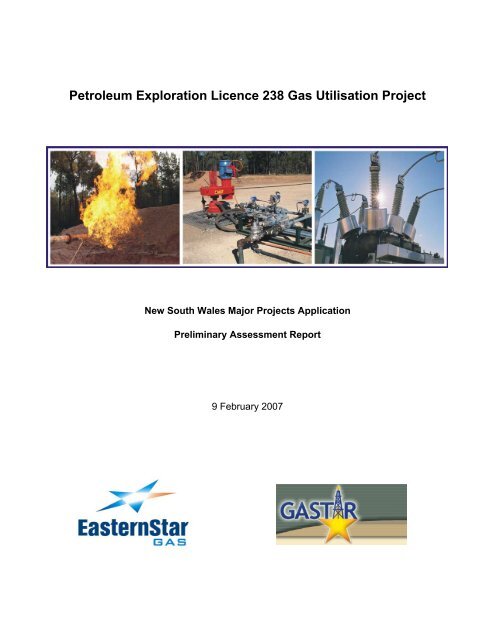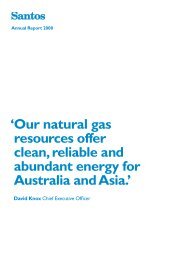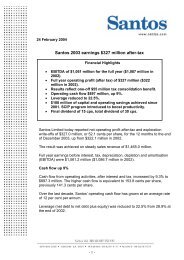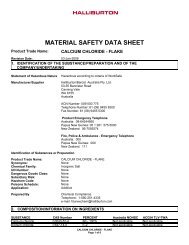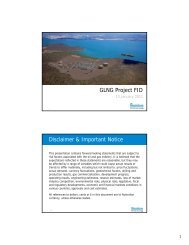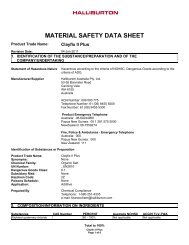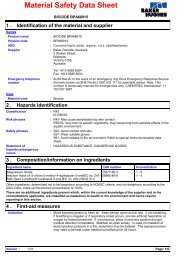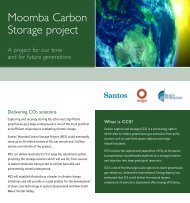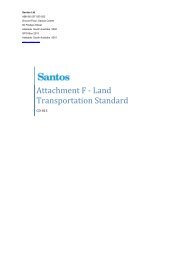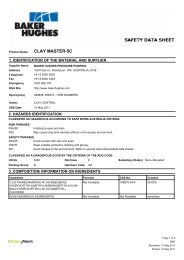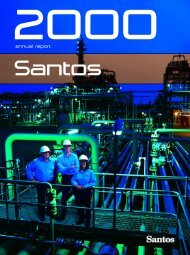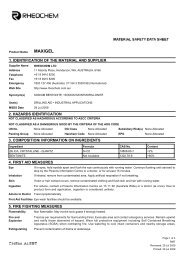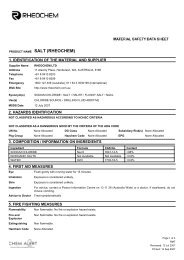Petroleum Exploration Licence 238 Gas Utilisation Project - Santos
Petroleum Exploration Licence 238 Gas Utilisation Project - Santos
Petroleum Exploration Licence 238 Gas Utilisation Project - Santos
Create successful ePaper yourself
Turn your PDF publications into a flip-book with our unique Google optimized e-Paper software.
<strong>Petroleum</strong> <strong>Exploration</strong> <strong>Licence</strong> <strong>238</strong> <strong>Gas</strong> <strong>Utilisation</strong> <strong>Project</strong><br />
New South Wales Major <strong>Project</strong>s Application<br />
Preliminary Assessment Report<br />
9 February 2007
Table of Contents<br />
1 Executive Summary ...........................................................................................................4<br />
2 Introduction.........................................................................................................................7<br />
2.1 PEL <strong>238</strong> Background .................................................................................................. 7<br />
2.2 CSG <strong>Project</strong> Structure................................................................................................. 8<br />
2.3 Existing Activities Within PEL <strong>238</strong> .............................................................................. 8<br />
2.3.1 Coonarah <strong>Gas</strong> Field and Wilga Park Power Station ........................................... 8<br />
2.3.2 Coal Seam <strong>Gas</strong> <strong>Exploration</strong> ................................................................................ 9<br />
3 Proposed <strong>Gas</strong> <strong>Utilisation</strong> <strong>Project</strong> .....................................................................................11<br />
3.1 <strong>Project</strong> Outline and Cost ........................................................................................... 11<br />
3.2 Components of the Major <strong>Project</strong> ............................................................................. 12<br />
3.2.1 <strong>Gas</strong> Gathering System ...................................................................................... 12<br />
3.2.2 Nodal Compression ........................................................................................... 12<br />
3.2.3 Flow Line (Bibblewindi to Wilga Park) ............................................................... 12<br />
3.2.4 Power Station Expansion................................................................................... 13<br />
3.2.5 Substation Upgrade ........................................................................................... 13<br />
4 Facilitating Initiatives ........................................................................................................14<br />
4.1.1 <strong>Petroleum</strong> Assessment Lease........................................................................... 14<br />
4.2 Long-lead Items ........................................................................................................ 14<br />
5 Legislative Considerations ...............................................................................................15<br />
5.1 Proposed Major <strong>Project</strong> - Why Part 3A?................................................................... 15<br />
5.2 Applicability of Part 3A to Proposed Major <strong>Project</strong> ................................................... 15<br />
5.3 <strong>Petroleum</strong> <strong>Exploration</strong> Activities in NSW .................................................................. 16<br />
5.4 Government Consultation ......................................................................................... 16<br />
5.5 Community Consultation........................................................................................... 17<br />
5.6 Commonwealth Legislation....................................................................................... 17<br />
5.7 Regional Planning Instruments ................................................................................. 18<br />
5.8 Local Planning Instruments....................................................................................... 18<br />
2
6 Initial Environmental Assessment ....................................................................................19<br />
6.1 Land use Management ............................................................................................. 19<br />
6.2 Flora .......................................................................................................................... 19<br />
6.3 Fauna ........................................................................................................................ 20<br />
6.4 Aboriginal Heritage.................................................................................................... 21<br />
6.5 European Heritage .................................................................................................... 21<br />
6.6 Water......................................................................................................................... 21<br />
6.6.1 Regional and Localised Drainage Systems....................................................... 22<br />
6.6.2 Creek Crossings ................................................................................................ 22<br />
6.7 Soils...........................................................................................................................23<br />
6.8 Air Quality.................................................................................................................. 23<br />
6.9 Noise ......................................................................................................................... 24<br />
6.10 Visual Amenity .......................................................................................................... 24<br />
6.11 Hazard....................................................................................................................... 24<br />
6.12 Traffic and Transport Management........................................................................... 25<br />
Figures<br />
Figure 1. <strong>Project</strong> location and pipeline route in relation to Narrabri.......................................... 5<br />
Tables<br />
Table 1. Major <strong>Project</strong> Works ............................................................................................. 11<br />
3
1 Executive Summary<br />
This Preliminary Assessment Report is submitted by Eastern Star <strong>Gas</strong> Limited on behalf of<br />
the Gunnedah <strong>Gas</strong> Joint Venture (“GGJV”), which comprises Eastern Star <strong>Gas</strong> 65% and<br />
<strong>Gas</strong>tar <strong>Exploration</strong> 35%. It provides information in support of the application for a gas<br />
gathering system, flow line and power station expansion project to be granted Major <strong>Project</strong><br />
status pursuant to State Environmental Planning Policy (Major <strong>Project</strong>s) 2005 and Part 3A of<br />
the Environmental Planning and Assessment Act 1979.<br />
The GGJV has completed stage one of a three stage program for the development of coal<br />
seam gas resources located within <strong>Petroleum</strong> <strong>Exploration</strong> <strong>Licence</strong> <strong>238</strong> (‘PEL <strong>238</strong>’), near<br />
Narrabri, NSW. Stage one involved total expenditure of approximately $39 million on a<br />
systematic evaluation of PEL <strong>238</strong>’s CSG resource, testing of various well completion<br />
techniques and subsequent gas production testing. On the basis of the stage one activity,<br />
the estimated gas-in-place within PEL <strong>238</strong> and the gas resource of PEL <strong>238</strong> have been<br />
independently certified at 17,000 PJ and 8,300 PJ, respectively.<br />
Stage two of the development program, which includes the first coal seam gas pilot<br />
production project located at Bibblewindi, is now well advanced with expenditure exceeding<br />
$26 million. The Stage two activities builds upon the wealth of previous coal seam gas<br />
exploration activity and has been specifically formulated to demonstrate the commerciality of<br />
producing CSG from PEL <strong>238</strong> and to establish a base of marketable gas reserves.<br />
As a complement to the Stage two activities, the GGJV proposes to undertake a major<br />
project that will avoid wasteful and environmentally undesirable venting or flaring of pilot<br />
production gas. The major project involves gathering and delivery of production test gas to<br />
the Wilga Park Power Station (WPPS) which will, in turn, be expanded from 11 MW to 40 MW<br />
nominal capacity. The budgeted cost for expansion of the power station and installation of<br />
gas gathering and flow line facilities to deliver gas to the Power Station exceeds $46 million.<br />
The GGJV has commenced long-lead time activities that must be completed in order that the<br />
gas flow line can be constructed by mid-2007. The application of the Major <strong>Project</strong>s SEPP<br />
and its assessment under Part 3A will facilitate inter-agency consultation and will contribute<br />
to the GGJV’s gas utilisation initiative being implemented in a timely manner.<br />
4
Figure 1. <strong>Project</strong> location and pipeline route in relation to Narrabri<br />
5
Definitions<br />
Bibblewindi CSG Pilot<br />
Bohena CSG <strong>Project</strong> Area<br />
Coal Seam <strong>Gas</strong> (CSG)<br />
Conventional natural gas<br />
Refers to the Gunnedah <strong>Gas</strong> Joint Venture’s current<br />
operational focus, a nine-spot pilot production program<br />
being implemented in the south eastern corner of the<br />
Bohena CSG <strong>Project</strong> Area<br />
The 265 square kilometre project area illustrated in Figure<br />
1, which contains an estimated 3.7 Petajoules of gas “in<br />
place” and is subject to a <strong>Petroleum</strong> Assessment Lease<br />
Application lodged with the Department of Primary<br />
Industries (Mineral Resources Division)<br />
Refers to the gases that are adsorbed to the internal pore<br />
surfaces of suitable coals. The gas is adsorbed under the<br />
effect of hydrostatic pressure and can be released when<br />
water is pumped from the coal, thereby reducing the<br />
pressure within the coal. CSG differs from conventional<br />
natural gas in that the coal acts as both the gas source and<br />
the gas reservoir<br />
Natural gas that is trapped within, and may be recovered<br />
from, pore spaces within a reservoir rock to which it has<br />
migrated<br />
Gunnedah <strong>Gas</strong> Joint Venture A joint venture between Eastern Star <strong>Gas</strong> Limited (65%)<br />
and <strong>Gas</strong>tar <strong>Exploration</strong> (35%) that was established to<br />
prove up and develop the CSG resource of PEL <strong>238</strong><br />
Indigenous <strong>Gas</strong> Resources<br />
Accumulations of natural gas (including coal seam gas)<br />
that are located inside the political boundary of New South<br />
Wales<br />
Petajoule (PJ) One Petajoule is 10 15 Joules. One PJ is approximately<br />
equivalent to 1 billion standard cubic feet (BCF) of gas or<br />
35,700 tonnes of coal<br />
Major <strong>Project</strong><br />
Refers to the installation of gas gathering and pipeline<br />
facilities to deliver CSG from PEL <strong>238</strong> to the Wilga Park<br />
Power Station and expansion of the power station<br />
6
2 Introduction<br />
NSW is almost entirely dependent upon gas imported from the Gippsland Basin (Victoria) and<br />
the Cooper Basin (South Australia) for supply of its residential, commercial and industrial<br />
needs. The availability of gas from the Cooper Basin is in decline and security of gas supply<br />
is an emerging major issue for Government and industry. If indigenous supplies of gas are<br />
not developed, the importation of gas from Queensland or further afield is likely to become<br />
necessary.<br />
The cost of gas that is imported into NSW from other states is high, owing to the unavoidable<br />
costs of transporting the gas over long distances, and is both a deterrent to the<br />
competitiveness and continued growth of NSW industry and a deterrent to expanded use of<br />
gas in environmentally friendly applications (for example, gas fired electricity generation).<br />
In addition, the State of NSW derives no royalty revenue from imported gas. The State will<br />
benefit significantly if its indigenous gas resources are harnessed, creating new streams of<br />
royalty income that can be used for other development or public service needs.<br />
2.1 PEL <strong>238</strong> Background<br />
Since its formation, initially as a private company in 2000, the strategic focus of Eastern Star<br />
<strong>Gas</strong> has been to prove up reserves of natural gas for sale into eastern Australian markets.<br />
Both conventional and coal seam gas reserves have been targeted, predominantly within<br />
NSW and with a particular focus on the Gunnedah Basin.<br />
Eastern Star <strong>Gas</strong> Limited (“Eastern Star”) was floated in February 2001 and, shortly after<br />
listing on the Australian Stock Exchange, acquired 100% ownership of <strong>Petroleum</strong> <strong>Exploration</strong><br />
<strong>Licence</strong> <strong>238</strong> (“PEL <strong>238</strong>”). PEL <strong>238</strong> is a 9,100 square kilometre licence area within which the<br />
highly prospective, coal bearing Bohena Trough area of the Permo-Triassic Gunnedah Basin<br />
is located. Encouraging gas flows had been encountered during earlier exploration activity<br />
(i.e., prior to the float of Eastern Star) on the Coonarah structure, a conventional natural gas<br />
resource located approximately 25 km west of Narrabri.<br />
After acquiring PEL <strong>238</strong>, Eastern Star sought to explore for and develop conventional natural<br />
gas within the permit area. In view of Eastern Star’s early focus on conventional gas, the<br />
7
ights to coal seam gas within PEL <strong>238</strong> were assigned under a strata title arrangement to<br />
First Source Energy Group (“FSG”). FSG and its NYMEX listed joint venture partner,<br />
Forcenergy, invested in excess of $39 million on CSG exploration and development activities<br />
that:<br />
• Confirmed the presence of very large resources of coal seam gas in two distinct and<br />
widespread coal measures; and<br />
• Indicated, on the basis of an independent reserve assessment there could be in<br />
excess of 17 TCF of gas in place within PEL <strong>238</strong>.<br />
In 2004, Eastern Star together with Hillgrove Resources Limited acquired an interest in the<br />
CSG resources of PEL <strong>238</strong> and funded a further phase of CSG development activity<br />
including a fully cored hole at Bohena South, a horizontal well at Bohena 4-L, vertical wells at<br />
Bohena South and Bohena-9 and fracture stimulation of the Bohena South-1, Bohena- 9 and<br />
Bibblewindi-1 wells.<br />
2.2 CSG <strong>Project</strong> Structure<br />
Coincident with the acquisition of the abovementioned interest in PEL <strong>238</strong>, the Gunnedah<br />
<strong>Gas</strong> Joint Venture (“GGJV”) was established as the vehicle for funding and pursuit of coal<br />
seam gas opportunities within the permit area. The Joint Venture presently comprises<br />
Eastern Star (65%) and <strong>Gas</strong>tar <strong>Exploration</strong> Ltd (35%) and is operated by Eastern Star.<br />
Eastern Star still retains 100% ownership of conventional natural gas rights within PEL <strong>238</strong>.<br />
The sole focus of the GGJV is commercialisation and development of the massive indigenous<br />
gas resources that are known to lie within the area of PEL <strong>238</strong>.<br />
2.3 Existing Activities Within PEL <strong>238</strong><br />
2.3.1 Coonarah <strong>Gas</strong> Field and Wilga Park Power Station<br />
Eastern Star commenced production of conventional natural gas from an Early Permian<br />
sandstone reservoir in the Coonarah <strong>Gas</strong> Field in July 2004. <strong>Gas</strong> is produced by means of<br />
five wells and is delivered through a gas gathering system and flow line to the purpose built<br />
Wilga Park Power Station. Electricity generated at Wilga Park is sold to Country Energy<br />
8
under a 10 year Power Purchase Agreement.<br />
The construction of the Coonarah gas gathering system and flow line was progressed:<br />
• Under Part 4 of the Environmental Planning and Assessment Act 1979, with the<br />
consent of the Narrabri Shire Council; and<br />
• Pursuant to the terms of <strong>Petroleum</strong> Production Lease No. 3.<br />
The Wilga Park Power Station incorporates eleven, one Megawatt Jenbacher gas<br />
reciprocating engine driven generators, plus relevant transformer and switchyard facilities,<br />
and is designed for continuous 24 hour operation. The total project cost approximated $16<br />
million and was commissioned in July 2004 with deliveries of electricity into Country Energy’s<br />
grid commencing on 11 July 2004. The electricity generated at the Wilga Park Power Station<br />
is supplied into Country Energy’s 66 kV distribution systems and is notionally delivered to<br />
Walgett, some 190km west of Narrabri.<br />
Following 12 months of sustained gas production from the Coonarah <strong>Gas</strong> Field, during which<br />
there was a noticeable decline in gas deliverability, a multifaceted review of the Coonarah<br />
reserves status was carried out. Unfortunately, the review led to a significant downgrade of<br />
the proven gas reserves of the Coonarah field, from 11 Petajoules originally estimated to 5.8<br />
Petajoules. As a result of the reserves downgrade, and in the absence of new sources of gas<br />
supply, the operating lifespan of the Wilga Park Power Station is likely to be the equivalent of<br />
only 4 to 5 years, or less. The power station is now being operated intermittently and at part<br />
load.<br />
2.3.2 Coal Seam <strong>Gas</strong> <strong>Exploration</strong><br />
Following the wealth of historic CSG focused exploration and appraisal activity conducted<br />
during Stage one, which confirmed the existence of significant quantities of CSG and<br />
identified appropriate well completion techniques, the GGJV implemented a nine-spot pilot<br />
production program (‘Stage 2’). The pilot production program has been specifically designed<br />
to fast-track commercialisation of CSG production from PEL <strong>238</strong> and to establish an initial<br />
base of gas reserves upon which gas sales activities may be founded.<br />
9
The pilot production program is located at Bibblewindi, to the southeast of Bohena (where the<br />
majority of previous CSG exploration activity was carried out). The Bibblewindi pilot<br />
production program involves the drilling, completion and production testing of nine wells<br />
designed to facilitate dewatering and initiate gas production at commercial rates. Bibblewindi<br />
was selected as the site for the present program since, among other things, target coal<br />
seams in the Bibblewindi location are thinner than is typical for the Bohena area which, given<br />
the high permeability of the target coal seams, should enable dewatering and gas production<br />
activities to be accelerated.<br />
The Bibblewindi pilot production program is well advanced; during 2006 the nine new wells<br />
were drilled and successfully fracture stimulated (or ‘fracced’). The frac program completed<br />
at Bibblewindi is, in terms of sand emplaced, one of the largest undertaken in the Australian<br />
CSG industry. The installation of wellhead facilities, pumps and ancillary surface equipment<br />
has now been completed and the wells sequentially brought on line. At the time of this<br />
submission, the Bibblewindi pilot is fully operational and the dewatering program underway.<br />
Water and gas production data gained during this stage, which will continue until at least the<br />
end of 2007, is a key input for estimation of the gas reserves over a defined area. <strong>Gas</strong><br />
reserve determination will be independently undertaken and certified by Netherland, Sewell<br />
and Associates.<br />
Water pumped from the target coal seam to initiate gas desorption will be transported through<br />
polyethylene pipelines for storage and evaporation in centrally located impoundments. <strong>Gas</strong><br />
that is produced during the reserves assessment process must, unless a feasible alternative<br />
can be found, be flared or otherwise disposed of until such time as the commercial viability of<br />
CSG production from Bibblewindi has been demonstrated and gas reserves established to<br />
allow long-term sales commitments and to underwrite large-scale infrastructure development.<br />
To avoid wasteful (and potentially environmentally undesirable) flaring of gas, Eastern Star<br />
proposes to implement a major project that will allow the gas to be used for electricity<br />
generation.<br />
10
3 Proposed <strong>Gas</strong> <strong>Utilisation</strong> <strong>Project</strong><br />
3.1 <strong>Project</strong> Outline and Cost<br />
Based upon reservoir modeling and predictions of well performance, it is anticipated that by<br />
mid-2007 CSG will be available from the Bibblewindi pilot production program at an<br />
aggregate rate approaching 7 to 10 TJ/d. An additional 0.1 to 0.5 TJ/d of gas is also<br />
available from Bohena exploration wells that are undergoing long-term production testing.<br />
Eastern Star intends to utilise the gas (that would otherwise be flared) to allow expansion and<br />
reversion to 24 hour operation of the Wilga Park Power Station.<br />
Works to be carried out (the “Major <strong>Project</strong>”) to allow utilisation of gas and expansion of the<br />
Wilga Park Power Station are detailed in Table 1. Expenditure already incurred on Stage two<br />
activities (including drilling, fraccing and well completion), which exceeds $12 million, is not<br />
considered part of the Major <strong>Project</strong> and has not been included in Table 1.<br />
Item<br />
Value<br />
<strong>Gas</strong> gathering system $520,000<br />
Nodal Compression $6,000,000<br />
Flow line $5,750,000<br />
Power Station Expansion (30 MW) $33,000,000<br />
Substation Upgrade $960,000<br />
Total $46,230,000<br />
Table 1.<br />
Major <strong>Project</strong> Works<br />
11
The total capital cost of the Major <strong>Project</strong> which, when completed will allow utilisation of CSG<br />
pilot production gas in the Wilga Park Power Station is $46.23 million. This satisfies the<br />
appropriate clauses of the major projects SEPP for determination by the Minister for Planning<br />
under Part 3A of the Environmental Planning and Assessment Act 1979.<br />
3.2 Components of the Major <strong>Project</strong><br />
3.2.1 <strong>Gas</strong> Gathering System<br />
A network of small diameter, polyethylene pipelines is required to transport production test<br />
gas from individual wells to the inlet location of the flow line to the Wilga Park Power Station.<br />
It is estimated that tie in of the wells to a central location will require the installation of 3.5 km<br />
of buried pipeline together with valving and associated equipment necessary for<br />
interconnection to nodal compression facilities. The estimated cost of the gas gathering<br />
system is $520,000 based upon:<br />
• An installed cost for polyethylene pipeline of $90 per meter; and<br />
• Provision of $205,000 for manifolds and valves.<br />
3.2.2 Nodal Compression<br />
Since the pressure at which gas is produced from coal seam gas wells is too low to allow the<br />
gas to be delivered to and used in the Wilga Park Power Station, gas compression facilities<br />
must be installed. Estimates suggest that 1,200 kW of compression power will be required.<br />
Based upon indicative prices for supply of gas engine driven compression equipment, the<br />
installed cost of the compression facility will exceed $6m and includes inlet gas filtration,<br />
control systems and installation.<br />
3.2.3 Flow Line (Bibblewindi to Wilga Park)<br />
To deliver gas from the Bibblewindi pilot production site to the Wilga Park Power station will<br />
require installation of a 36 km long flow line nominally 250 mm in diameter. The route of the<br />
proposed flow line is shown in Figure 1. Subject to final bid prices, it is proposed the flow line<br />
will be constructed using fiberglass reinforced epoxy (“GRE”) pipe. Indicative pricing for<br />
12
supply and installation of a GRE flow line has been sourced. The independently estimated<br />
cost of the flow line is $5.75m, not including provision for inlet or outlet facilities or<br />
connections.<br />
3.2.4 Power Station Expansion<br />
The Wilga Park Power station will be expanded to 40 MW by installation of additional<br />
reciprocating engine driven generators. The installed cost of generators in the 3 MW size<br />
range exceeds $1,100 per kW of capacity giving a total cost for the 30 MW expansion of<br />
$33m to $39m.<br />
3.2.5 Substation Upgrade<br />
The Wilga Park Power Station supplies electricity into Country Energy’s 66 kV network<br />
through a substation adjacent to the power station. The substation will need to be upgraded<br />
to handle the output from the expanded power station. This will involve installation of a larger<br />
transformer and additional circuit breaker equipment. Based upon a budget price for the<br />
transformer upgrade plus provision for other additional equipment, the estimated cost of the<br />
substation upgrade is $960,000.<br />
13
4 Facilitating Initiatives<br />
4.1.1 <strong>Petroleum</strong> Assessment Lease<br />
Eastern Star is awaiting determination on a <strong>Petroleum</strong> Assessment Lease Application<br />
(“PALA”) submitted to the Department of Primary Industries (Mineral Resources Division) in<br />
2005. The PALA covers the 265 square kilometre Bohena CSG <strong>Project</strong> Area (Figure 1) and,<br />
when granted, will facilitate ongoing resource assessment activities including use of CSG at<br />
the Wilga Park Power Station during the transition between the exploration and production<br />
phases of the <strong>Project</strong>.<br />
The assessment lease is an interim step linking the exploration and production licences and<br />
grants a:<br />
“retention of rights over an area in which a significant petroleum deposit has been<br />
identified, if mining the deposit is not commercially viable in the short term but there is<br />
a reasonable prospect that it will be in the longer term.”<br />
The GGJV considers the granting of the PAL as an important step towards the creation of a<br />
larger, commercial development. An assessment lease also signifies the Government’s<br />
approval in principle to production in the project area.<br />
4.2 Long-lead Items<br />
In order that the flow line can be installed and operational by mid 2007, work on a number of<br />
long-lead items has already been initiated. In particular, route selection and land-access<br />
activities (including discussions with Narrabri Shire Council and landholders) and<br />
environmental review activities have already commenced or are scheduled.<br />
14
5 Legislative Considerations<br />
5.1 Proposed Major <strong>Project</strong> - Why Part 3A?<br />
Planning activities carried out to date indicate the proposed Major <strong>Project</strong> may be subject to<br />
assessment under a range of NSW legislation including (but not limited to):<br />
• Local Government Act 1993<br />
• Crown Lands Act 1989<br />
• Roads Act 1993<br />
• Threatened Species Conservation<br />
Act 1995<br />
• Forestry Act 1916<br />
• Native Title Act 1994<br />
• River and Foreshores Improvement<br />
Act 1948<br />
• Native Vegetation Act 2003<br />
• Heritage Act 1997<br />
• <strong>Petroleum</strong> (Onshore) Act 1991<br />
• Protection of the Environment<br />
Operations Act 1997<br />
Coordination of Government, Departmental, community and other public participation<br />
required to establish the framework of approvals necessary for implementation of the Major<br />
<strong>Project</strong> may therefore be a burdensome and time-consuming process. In the absence of any<br />
alternative this responsibility will lie with the Narrabri Shire Council as the consent authority.<br />
For the proposed Major <strong>Project</strong>, application of Part 3A of the Environmental Planning and<br />
Assessment Act 1979 offers an attractive alternative. The application of Part 3A will facilitate<br />
inter-agency consultation and approvals processes and will contribute to the GGJV’s Major<br />
<strong>Project</strong> initiative being implemented in a timely manner.<br />
5.2 Applicability of Part 3A to Proposed Major <strong>Project</strong><br />
As part of a recent reform of planning legislation the NSW Government implemented<br />
initiatives that are directed at providing “a separate streamlined and integrated development<br />
assessment and approvals regime for major infrastructure and other projects of significance<br />
to the State…” (Planning NSW Fact Sheet, August 2005)<br />
Specifically, the NSW State Environmental Planning Policy (Major <strong>Project</strong>s) 2005 specifies<br />
classes of developments that exceed the minimum capital investment value and/or<br />
15
employment qualifier and are therefore to be assessed under Part 3A of the Environmental<br />
Planning and Assessment Act 1979 and determined by the Minister for Planning. Clause 24,<br />
Schedule 1 of the State Environmental Planning Policy (Major <strong>Project</strong>s) 2005 provides that<br />
projects of the following nature are projects to which Part 3A will apply.<br />
Clause 24 “Development for the purpose of an electricity generation facility that:<br />
(a) has a capital investment value of more than $30 million for gas or coal-fired<br />
generation…”<br />
The proposed Major <strong>Project</strong>, incorporating the gas gathering system, flow line and electricity<br />
generation facilities will require estimated capital investment exceeding $46m, thereby<br />
exceeding the minimum capital investment value of $30 million as prescribed in the<br />
aforementioned Schedule 1 of the State Environmental Planning Policy (Major <strong>Project</strong>s) 2005<br />
for electricity generation facilities.<br />
5.3 <strong>Petroleum</strong> <strong>Exploration</strong> Activities in NSW<br />
The Minister for Mineral Resources (“Minister”) and the NSW Department of Primary<br />
Industries, Mineral Resource Division (“Mineral Resources”) are the consent authority for<br />
petroleum exploration, assessment and production in NSW under the <strong>Petroleum</strong> (Onshore)<br />
Act 1991. The partial or whole conversion of <strong>Petroleum</strong> <strong>Exploration</strong> <strong>Licence</strong> <strong>238</strong> into a<br />
<strong>Petroleum</strong> Assessment Lease or a <strong>Petroleum</strong> Production Lease requires the approval and<br />
consent of the Minister under this Act. The GGJV will, in consultation with the Minister for<br />
Mineral Resources, seek the appropriate conversion pathway that will facilitate the<br />
development of the CSG <strong>Project</strong> in consideration of the applicable Commonwealth, State and<br />
Local Government planning legislation and instruments.<br />
5.4 Government Consultation<br />
Development of the CSG project to date has occurred in close collaboration with a range of<br />
Local and State Government Agencies and Non Government Organisations including:<br />
• Narrabri Shire Council<br />
• NSW Department of Primary Industries - Mineral Resources;<br />
• NSW Department of Primary Industries – Forestry NSW;<br />
16
• NSW Department of Primary Industries – Agriculture<br />
• NSW Department of Primary Industries – Fisheries NSW<br />
• NSW Department of Natural Resources<br />
• NSW Department of Environment and Conservation – Environment Protection<br />
• NSW Department of Environment and Conservation – National Parks and Wildlife<br />
Service<br />
• Pilliga Forest Aboriginal Management Committee<br />
• Narrabri Local Aboriginal Land Council<br />
5.5 Community Consultation<br />
Development of the petroleum resource potential of PEL <strong>238</strong> has occurred with the significant<br />
support of local and regional communities.<br />
In relation to the GGJV’s <strong>Petroleum</strong> Assessment Lease Application and the proposed Major<br />
<strong>Project</strong>, direct community consultation occurred via a public meeting in preparation for the<br />
submission of PALA. Each landholder affected by the development of the Major <strong>Project</strong> has<br />
been contacted and given an opportunity to participate in the locating of flow line easements<br />
and to develop access and compensation agreements.<br />
Eastern Star has been well supported in the local press since developing the Coonarah <strong>Gas</strong><br />
Field, Pipeline and Wilga Park Power Station and in its role as operator of the CSG <strong>Project</strong>.<br />
5.6 Commonwealth Legislation<br />
Eastern Star <strong>Gas</strong> has (on behalf of the GGJV) commenced preliminary investigations that will<br />
characterise the applicability of the (Cwth) Environmental Protection and Biodiversity<br />
Conservation Act 1999, particularly Part 3 (S18.ss 2-6) which prohibits actions likely to result<br />
in significant impact on listed threatened species or endangered communities of national<br />
significance.<br />
The completion of preliminary flora and fauna studies across the project area suggests that<br />
the proposed activity will not trigger an assessment under the EPBC Act. Additional field<br />
based surveying in preparation for the environmental assessment will adequately<br />
characterise the role of the EPBC Act in the minimisation of environmental impacts<br />
17
associated with the project.<br />
5.7 Regional Planning Instruments<br />
The proposed Major <strong>Project</strong> is not subject to any specified Regional Environmental Plans for<br />
the Western Division in which the project site is located.<br />
5.8 Local Planning Instruments<br />
The proposed Major <strong>Project</strong> is wholly located within the Narrabri Local Government Area and<br />
is subject to the various provisions of Narrabri Local Environment Plan 1992 (“NLEP”).<br />
The southern portion of the proposed gas pipeline development is located entirely upon lands<br />
designated Crown Lands State Forests under the Forestry Act 1916.<br />
The northern portion of the proposed gas pipeline development is located upon land<br />
designated by the NLEP as Zone 1(a) (General Rural). The proposed activity is permissible<br />
under the NLEP and will require the development consent of the Narrabri Shire Council. The<br />
original, 2003/04 development of the Wilga Park Power Station occurred upon lands<br />
designated by the NLEP as Zone 1(a) (General Rural) and under a Part 4 Development<br />
Consent subject of approval of the Narrabri Shire Council. The development application on<br />
this zoned site was additionally subject to (NLEP) Regulation 22 – Development of flood<br />
liable land and Schedule 5 (Clause 19) – Industries, other than rural industries in zone 1(a).<br />
Expansion of the Wilga Park Power Station may be subject to a modification of the<br />
Development Consent.<br />
The submission and subsequent endorsement of an appropriate development application by<br />
the Narrabri Shire Council will sufficiently account for Section 75J subsection 3(b) of the<br />
Environmental Planning and Assessment Act 1979 which stipulates the Minister cannot<br />
approve the carrying out of a project wholly prohibited under an environmental planning<br />
instrument.<br />
18
6 Initial Environmental Assessment<br />
The following subsections outline environmental issues that the GGJV anticipates will need to<br />
be addressed in the course of implementing the Major <strong>Project</strong>.<br />
6.1 Land use Management<br />
The Major <strong>Project</strong> spans a number of land use types and jurisdictions including (but not<br />
limited to) Crown Lands State Forest, freehold/leasehold farmland and, in regard to the<br />
crossing of Bohena Creek, Protected Lands as defined in the River and Foreshores<br />
Improvement Act 1948.<br />
An important consideration during preliminary planning of the proposed gas gathering system<br />
and flow line has been minimisation of the impact of the development upon the land over<br />
which it passes e.g. the gas gathering and flow line infrastructure will be located on existing<br />
tracks, roads and/or fence lines where practicable. The flow line will also be buried with a<br />
minimum cover of 750mm which will generally mean pre-existing land-use activities can be<br />
continued after construction is completed. Furthermore, due compensation will be made to<br />
affected landholders pursuant to land access or easement agreements established with<br />
landholders.<br />
Environmental Assessment studies carried out for the proposed Major <strong>Project</strong> will contain a<br />
full review and evaluation of land use management issues. A management plan will be<br />
developed to address potential land-use impacts.<br />
6.2 Flora<br />
Prior to completion of the 2002 Pilliga East Seismic Survey, the flora composition of the<br />
Pilliga State Forest (including species types, quality and population, and faunal habitat) had<br />
received little attention by way of data collection. Since the 2002 survey the GGJV has<br />
conducted a further four botanical surveys over the area within which CSG related activities<br />
are presently focused. As a result, the floristic composition of the northern Pilliga is now well<br />
understood and likely and potential impacts of proposed developments can be confidently<br />
predicted.<br />
19
Based upon survey work to date the following observations can be made:<br />
• Endangered communities listed in the NSW Threatened Species Conservation Act<br />
1995 and Environmental Protection and Biodiversity Conservation Act 1999 (Cwth)<br />
have not been detected in the area of CSG activities and are therefore unlikely to be of<br />
concern for the proposed Major <strong>Project</strong>; and<br />
• Habitat requirements for five threatened flora species may be met in the study area,<br />
but as threatened flora species have not been previously recorded in the study area<br />
and have not been detected in the surveying, the possibility that they do occur there is<br />
considered to be low.<br />
Further surveying of the gas gathering and flow line routes will be undertaken to evaluate the<br />
likelihood that construction or operation of the infrastructure will have an impact on any<br />
species or communities of significance. Relationships between the floristic composition and<br />
habitat quality for faunal species identified as inhabiting the project area will also be<br />
characterized as part of the further survey.<br />
6.3 Fauna<br />
Faunal species data for the Pilliga East State Forest was also scarce prior to completion of<br />
the 2002 Pilliga East Seismic Survey. Studies completed for the 2002 survey indicate that<br />
the Pilliga State Forest and Nature Reserve have national, state and regional conservation<br />
significance for the protection of biodiversity and threatened species. This significance is<br />
primarily due to the large size of the area (>500 000 ha), the high diversity of threatened<br />
species within the area and the high quality of habitat.<br />
Four additional fauna surveys completed between 2002 and 2007 have demonstrated that:<br />
• Twelve threatened fauna species have been recorded across the CSG project area,<br />
namely: Barking Owl; Hooded Robin; Speckled Warbler; Long-eared Bat; Brown<br />
Treecreeper; Glossy Black Cockatoo; Koala; Grey Crowed Babbler; Pilliga Mouse;<br />
Turquoise Parrot; Masked Owl; and Yellow-bellied Sheathtail Bat;<br />
• A majority of the threatened species inhabiting the CSG project area are mobile (i.e.<br />
20
avian or chiropteran species), occupy reasonably large home ranges and utilise the<br />
main vegetation communities as diurnal/nocturnal refugia; and<br />
• Mitigative action can be implemented to reduce potential impacts on these species to<br />
an acceptable level.<br />
In preparation for the Environmental Assessment, further surveying will be completed on the<br />
GGS and flow line route. Specific strategies for the mitigation of likely and potential impacts<br />
on species and communities of significance and actual habitat will be formulated.<br />
6.4 Aboriginal Heritage<br />
Information regarding Aboriginal inhabitation of the region comprises a number of site<br />
registers, previous Aboriginal heritage survey reports and the existing knowledge-base of<br />
local Aboriginal Land Councils and other management committees. All CSG related activities<br />
have been carried out with approval of the Narrabri Local Aboriginal Land Councils (NLALC)<br />
and, in the case of the Pilliga State Forests, endorsement of the Pilliga Forests Aboriginal<br />
Management Committee (PFAMC).<br />
Cultural heritage assessment activities to be undertaken as part of the proposed Major<br />
<strong>Project</strong> will involve consultation with appropriate heritage registers and field surveying of<br />
access corridors and development sites. The planning, field surveying and documentation of<br />
the Aboriginal heritage assessment will be carried out in collaboration with the NLALC and<br />
PFAMC with the final location of the GGS and flow line infrastructure subject to the outcomes<br />
of the assessment.<br />
6.5 European Heritage<br />
Preliminary consultation with the NSW Heritage Register indicates there are no known<br />
heritage items within the CSG project area. Further surveying will occur as part of<br />
Environmental Assessment activities.<br />
6.6 Water<br />
The GGJV has approved strategies in place for treatment, storage and disposal of water that<br />
is produced as a result of its CSG exploration and development activities. These activities<br />
21
and water management strategies are not impacted by the proposed Major <strong>Project</strong>.<br />
Limited volumes of water will be required during the construction and operation of the<br />
proposed Major <strong>Project</strong>. The water will be sourced from existing DNR licensed water bores<br />
located at Bibblewindi or from licensed water supplies in the Narrabri Township. An estimate<br />
of the volumes required for the proposed Major <strong>Project</strong> will be prepared as part of<br />
Environmental Assessment work undertaken for the project, and likely impacts of its<br />
utilisation will be addressed.<br />
6.6.1 Regional and Localised Drainage Systems<br />
The proposed Major <strong>Project</strong> is located within the western portion of the Namoi River Basin,<br />
where the regional topography is characterised by generally flat terrain and flood plains of<br />
less that 1° slope. The northern edge of the catchment is defined by Mount Kaputar and the<br />
Nandewar Ranges.<br />
The project site drainage is dominated by floodplains associated with three ephemeral<br />
tributaries of the Namoi River. The Bohena Creek is the dominant drainage line running from<br />
south to north through the entire project area and is a well defined, low sinuosity sand<br />
channel capable of accepting significant volumes of surface runoff during periods of high<br />
surface flow. Located within cleared farmland to the north of the CSG project area are the<br />
poorly defined creek channels of Bundock and Mollee Creeks.<br />
As part of Environmental Assessment activities, the GGJV will consider the relationship of the<br />
proposed Major <strong>Project</strong> with the topographic character of the project site including the likely<br />
and potential impacts on local and regional drainage features.<br />
6.6.2 Creek Crossings<br />
The flow line from Bibblewindi to the Wilga Park Power Station will cross one ephemeral<br />
creek adjacent to the Bibblewindi CSG pilot production project. The creek crossing will be<br />
carried out using trench and fill techniques at a location selected to avoid impact upon water<br />
lands. The potential for short-term biophysical impacts during construction of the flow line will<br />
be addressed during Environmental Assessment work and management plans formulated.<br />
22
6.7 Soils<br />
The likely impacts of the proposed Major <strong>Project</strong> on local soil resources do not differ from<br />
those identified during planning for CSG exploration activities within PEL <strong>238</strong>. Experience<br />
gained during the conduct of baseline surveys for the Coonarah <strong>Gas</strong> Field Statement of<br />
Environmental Effects and the related Coonarah <strong>Gas</strong> <strong>Project</strong> <strong>Petroleum</strong> Production<br />
Environmental Operations Plan (both of which relate to <strong>Petroleum</strong> Production Lease No.3)<br />
will contribute to successful mitigation on soil resource impacts.<br />
Field investigations and geotechnical assessments will be carried out as part of<br />
Environmental Assessment work for the proposed Major <strong>Project</strong>. These assessments will<br />
complement the existing knowledge base on soils management and will allow formulation of<br />
safeguards and techniques for management of soil erosion and control of sediments both<br />
during and after project construction.<br />
6.8 Air Quality<br />
The production of CSG and its use as a fuel for electricity generation is a desirable alternative<br />
to coal fired power generation, the latter option leading to higher levels of CO 2 and particulate<br />
emission. Reductions in greenhouse gas production leading to the creation of NSW<br />
Greenhouse <strong>Gas</strong> Abatement Certificates are a positive benefit of natural gas fueled electricity<br />
generation.<br />
Although expansion of the Wilga Park Power Station will lead to increased exhaust gas<br />
emissions, the GGJV does not expect development or operation of the proposed Major<br />
<strong>Project</strong> to pose any measurable threat to the quality of air in the localised or surrounding<br />
environments. Nonetheless, potential point and diffuse sources of air pollution and their<br />
impact upon air quality will be assessed as part of Environmental Assessment activities<br />
carried out for the proposed Major <strong>Project</strong>. In particular, empirical data on emissions of CO,<br />
CO 2 and NO X will be analysed and strategies identified to mitigate potential, if any, for a<br />
decline in air quality in the vicinity of the power station.<br />
23
6.9 Noise<br />
Impact assessment studies completed prior to development of the Wilga Park Power Station<br />
in 2002 demonstrated that noise impacts from operation of the existing facility were likely to<br />
remain in compliance with EPA industrial noise policies. The GGJV does not expect<br />
operation of the expanded Wilga Park Power Station to result in measurable noise impacts in<br />
the localised or surrounding environment however, the potential for increased noise impacts<br />
on the environment and rural properties surrounding the power station site will however be<br />
addressed as part of Environmental Assessment work carried out for the proposed Major<br />
<strong>Project</strong>.<br />
Noise arising during construction of the proposed Major <strong>Project</strong> will also be specifically<br />
addressed during Environmental Assessment activities and appropriate management plan<br />
formulated.<br />
6.10 Visual Amenity<br />
The installation of the gas gathering system and gas flow line will not result in any specified<br />
or long term decline in visual amenity, including through the Pilliga State Forests system.<br />
The Wilga Park Power Station does not present any adverse visual impacts since there is a<br />
considerable vegetative buffer around the power station and the surrounding topography is<br />
flat. The extent if any to which expansion of the power station may have an impact on visual<br />
amenity will be re-evaluated during the completion of the Environmental Assessment.<br />
6.11 Hazard<br />
Environmental risk assessments will be undertaken to identify residual risks arising from<br />
production, transportation and use of CSG for power generation and that cannot be<br />
accounted for through existing management planning, training and reporting procedures. It is<br />
proposed that a suitable environmental risk assessment will be undertaken as part of<br />
Environmental Assessment activities including screening for State Environmental Planning<br />
Policy 33 (Hazardous and Offensive Development).<br />
24
6.12 Traffic and Transport Management<br />
During the construction phase of the proposed Major <strong>Project</strong> it is likely that short term<br />
increases in localised vehicular traffic may occur. Aside from the statutory transport and<br />
permitting requirements related to the transportation of over-sized loads, Environmental<br />
Assessment activities will incorporate an evaluation of the localised traffic increases and will<br />
outline a traffic management plan to mitigate potential impacts on the community and other<br />
road users.<br />
25


